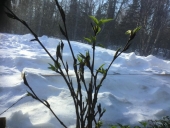
 2
2




“Once a wise man told me, ‘Family don’t end in blood,’ but it doesn’t start there either. Family cares about you. Not what you can do for them. Family is there, for the good, bad, all of it. They got your back. Even when it hurts. That’s family.”
 5
5




I make a Maple Syrup instructional movie! Check it out HERE
SKIP books, get 'em while they're hot!!! Skills to Inherit Property
See me in a movie building a massive wood staircase:Low Tech Lab Movie
 3
3




“Once a wise man told me, ‘Family don’t end in blood,’ but it doesn’t start there either. Family cares about you. Not what you can do for them. Family is there, for the good, bad, all of it. They got your back. Even when it hurts. That’s family.”
 4
4








 .
.“Once a wise man told me, ‘Family don’t end in blood,’ but it doesn’t start there either. Family cares about you. Not what you can do for them. Family is there, for the good, bad, all of it. They got your back. Even when it hurts. That’s family.”
 4
4









 5
5




Jonathan Ward wrote:It was in place when the neighborhood was build 35yrs ago and was big then. i was thinking about another week in the cup then on to a pot but wasn't sure. I also assumed i'd need to keep the pot fairly wet since the roots were grown in water.
List of Bryant RedHawk's Epic Soil Series Threads We love visitors, that's why we live in a secluded cabin deep in the woods. "Buzzard's Roost (Asnikiye Heca) Farm." Promoting permaculture to save our planet.




“Once a wise man told me, ‘Family don’t end in blood,’ but it doesn’t start there either. Family cares about you. Not what you can do for them. Family is there, for the good, bad, all of it. They got your back. Even when it hurts. That’s family.”












 2
2




List of Bryant RedHawk's Epic Soil Series Threads We love visitors, that's why we live in a secluded cabin deep in the woods. "Buzzard's Roost (Asnikiye Heca) Farm." Promoting permaculture to save our planet.
 1
1




![Filename: 67706787_868259000226999_8493598376766472192_n.jpg
Description: Now planted [Thumbnail for 67706787_868259000226999_8493598376766472192_n.jpg]](/t/119077/a/84644/67706787_868259000226999_8493598376766472192_n.jpg)
“Once a wise man told me, ‘Family don’t end in blood,’ but it doesn’t start there either. Family cares about you. Not what you can do for them. Family is there, for the good, bad, all of it. They got your back. Even when it hurts. That’s family.”




Check out the Food Forest Card Game: https://permies.com/wiki/141665/Food-Forest-card-game-English

|
I coulda been a contender. I coulda been somebody. Instead, I'm a tiny ad.
Rocket Mass Heater Resources Wiki
https://permies.com/w/rmh-resources
|



